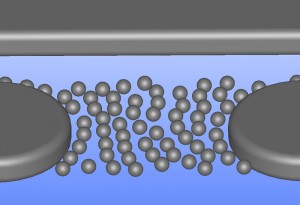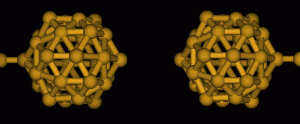
Mutli-scale modeling of nanoparticle based transistors
For half a century the integrated circuits (ICs) that make up the heart of electronic devices have been steadily improving by shrinking at an exponential rate. However, as the current crop of ICs get smaller and the insulating layers involved become thinner, electrons leak through due to quantum mechanical tunneling. This is one of several issues which will bring an end to the party, after which future improvements will have to come from employing fundamentally different transistor architecture rather than fine tuning and miniaturizing the field effect transistors in use today.
Several new transistor designs, some designed and built here at Tech, involve electrons tunneling their way through arrays of nanoparticles. We use a multi-scale approach to model these devices and study their behavior. For the smallest details of how often electrons jump from one particular nanoparticle to another, we use a first principles approach (density functional theory) to study the quantum mechanics involved. To estimate the change in energy due to the movement of a single electron, we use the finite element method to calculate electrostatic capacitances. The kinetic Monte Carlo method allows us to use our knowledge of these details to simulate an entire device — sometimes consisting of hundreds of individual particles — and watch as a device ‘turns on’ and starts conducting an electric current. Finally, we are developing new algorithms that will allow us to simulate the collective behavior of thousands of devices.
This work is ongoing under the advisement of Dr. John Jaszczak, in collaboration with the research groups of Dr. Pandey, Dr. Bergstrom, and Dr. Yap, and with support from the Miles fellowship.
